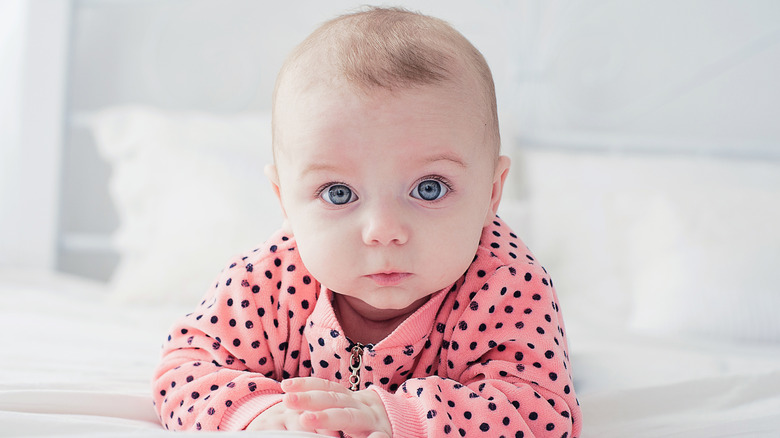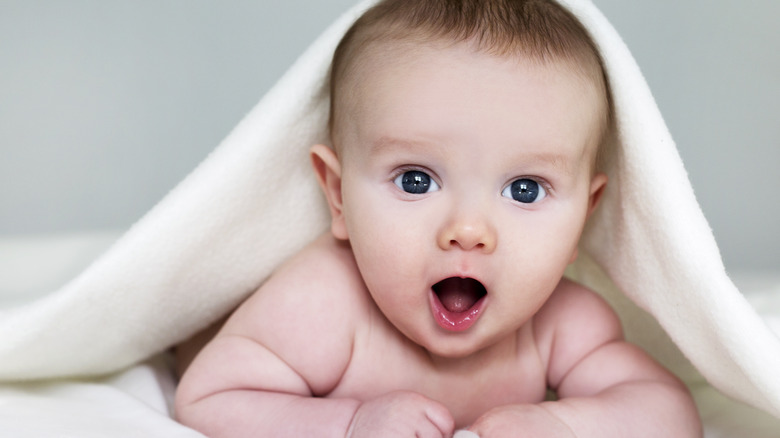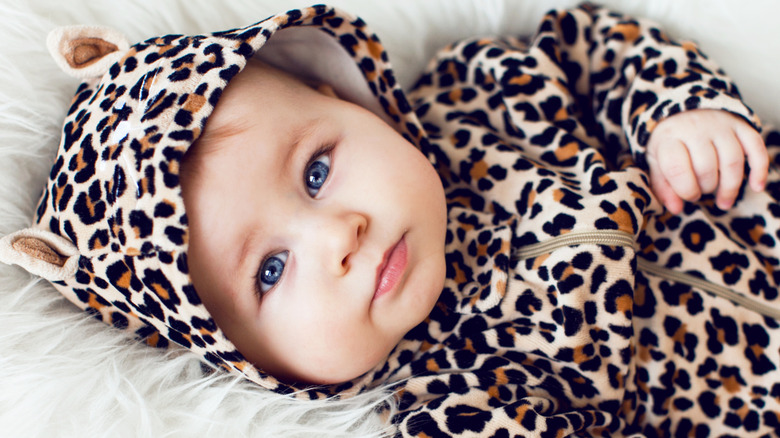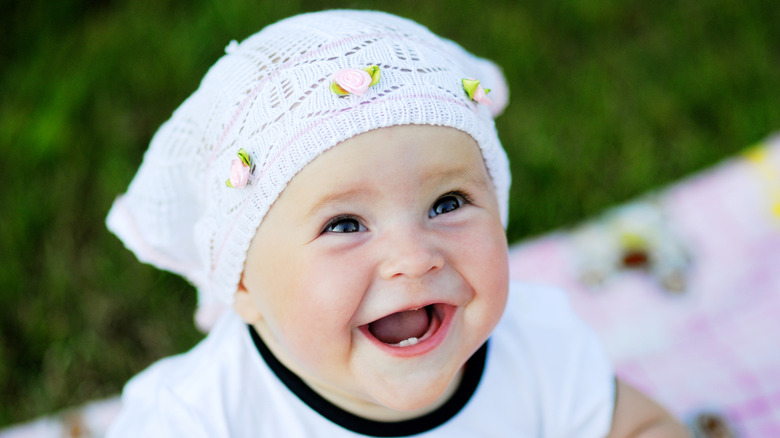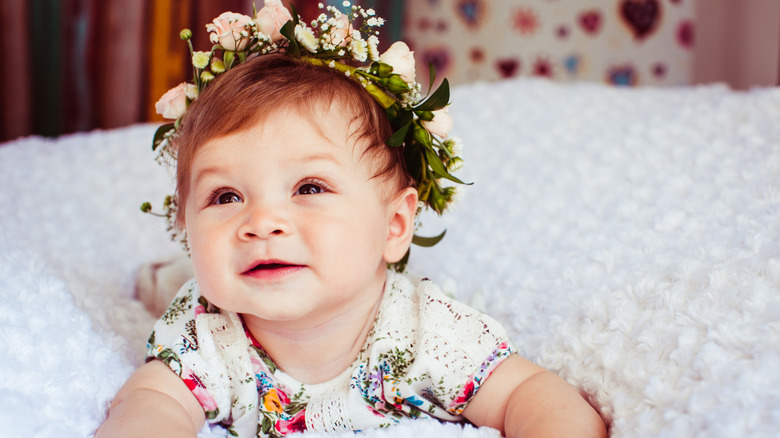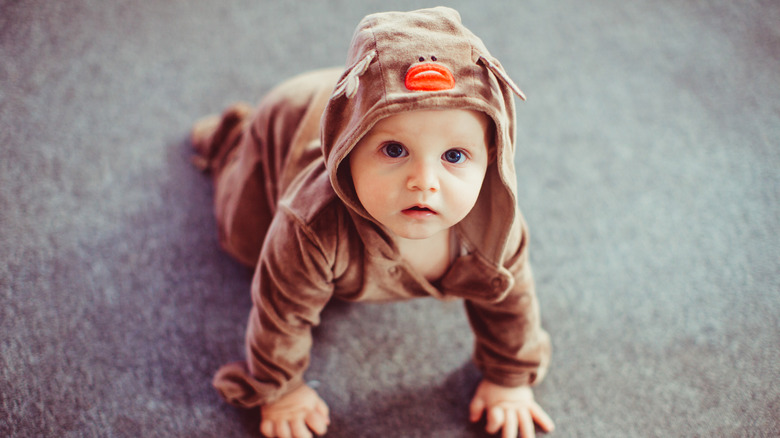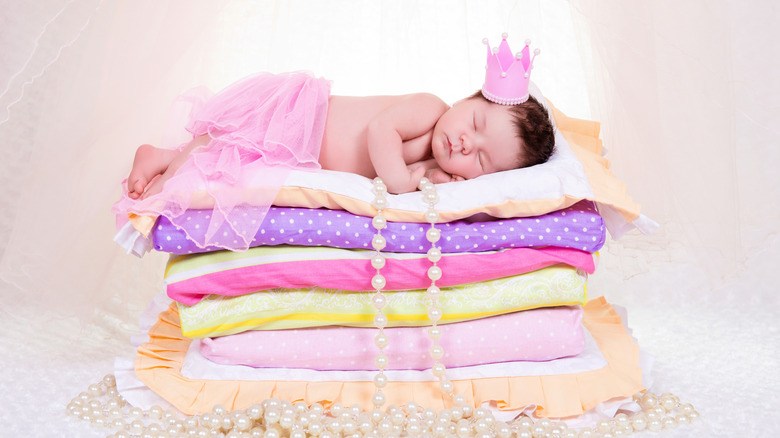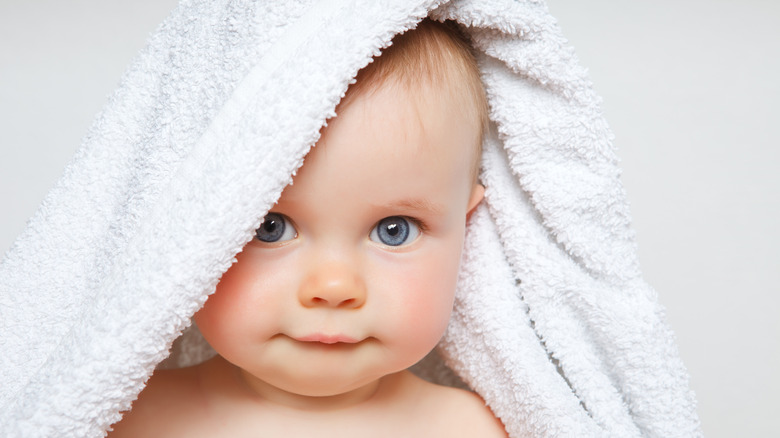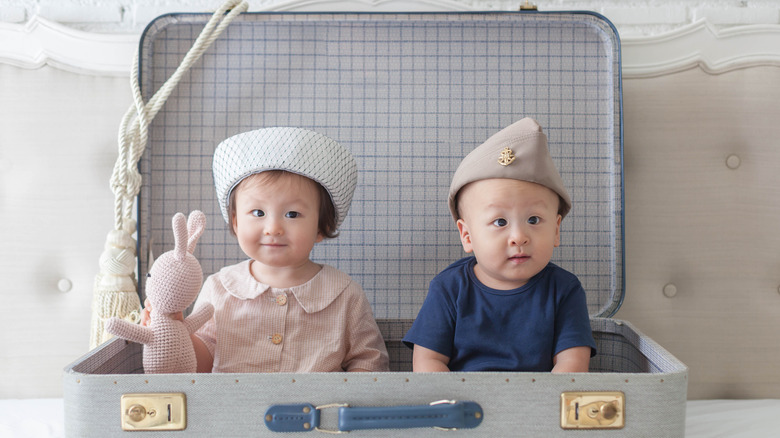The Most Popular Baby Names The Year You Were Born
Names are known to go in and out of style. Some names maintain their hold for generations, while for others, fame is fickle. Whether you have a name that was trending when you were born, or had parents who gave you an old-fashioned or unpopular name, it can be interesting to see how names have changed in popularity over time. If you've ever wanted to know the most popular names in the year you were born, keep reading!
1953-1955: There's something about Mary (and Robert)
The 1950s were all about tradition. The top five most popular names for baby boys born from 1953 to 1955 were Robert, James, Michael, John, and David. Traditional names were also in vogue for girls, with the top five names being Mary, Linda, Deborah, Patricia, and Susan.
All of the most popular names in these years have centuries of history behind them. Most of them have Biblical roots, with the exceptions of Robert and Linda, which date back to medieval times. The trend of traditional names can likely be attributed to the 1950s being a period of religious fervor in the United States.
1956: Deborah gets a makeover
By 1956, the same male names were in the top five, although Michael inched up to claim the honor of being the most popular, followed by James, Robert, David, and John. Even though Mary still held the number one spot for girls, the name Deborah proved to be even more popular seeing as it held two spot in the top five... kind of. It remained in the top five, while its spelling variation Debra jumped up to number two. The name Deborah was so popular that it was even occasionally used as a male name in this period.
While Debra peaked in popularity in the 1950s, its reign was brief. Rarely used before 1934, Debra is seldom seen today, with parents preferring the more traditional spelling of Deborah.
1957-1958: Keeping up with Karen
In 1957, Karen entered the top five names for baby girls at number five, replacing Deborah. The names Michael, James, David, Robert, and John remained popular for boys, as did Mary, Susan, Linda, and Debra for girls.
Karen, a Danish variation of the name Katherine, started gaining prominence in the U.S. in the 1930s. From there, it kept growing in popularity. At the height of its fame, the feminine name was also sometimes given to boys.
1959-1960: Oh, Donna
In 1959, Donna broke into the top five names for girls. The name is the Italian word for "lady," its surge in popularity followed the release of the 1958 hit song "Donna," by Ritchie Valens. Just months after the song became a hit, Valens died in a plane crash with musicians J.P. Richardson and Buddy Holly. This made the name "Donna" even more iconic as it was one of the few songs recorded by Valens, who would later be inducted into the Rock and Roll Hall of Fame.
1961-1964: Lisa leaps to the top
In 1961, Michael and Mary remained at the top of the boys and girls lists, as did most of the other names in the top 10. The only new name in the rankings was Lisa, which came in at number two for girls that year. The year before it crossed the threshold into the top 5, Lisa began to gain some ground as a boys name as well, although it never became as popular for boys as it did for girls.
By 1962, Lisa overtook Mary as the most popular girls name, a position it held until 1969.
1965: Kimberly catches on
By 1965, the grip of traditional names was starting to loosen. While the most popular boys names remained the same, the girls list started becoming more modern. Kimberly, which comes from a South African city and only began being used as a given name in the 20th century, entered the top five names for girls. While it started out as a gender neutral name, it never became popular for boys and is primarily thought of as a feminine name.
1966-1967: Michelle is a smash hit
More changes to the roster of popular girls names came in 1966. The top boys names remained unchanged, but Michelle became a beloved name for baby girls. This was likely influenced by the Beatles song "Michelle," which was recorded in 1965 and would go on to win a Grammy for Song of the Year in 1967. The French name only began to be used in the English-speaking countries in the mid-20th century, and the popularity of the song helped it become even more well-known.
Michelle's popularity could also be partially attributed to the enduring popularity of the name Michael, which remained the number one boys name. Michelle is the feminine form of Michel, the French variation of Michael.
1967-1969: Jennifer and Melissa begin their reign
Two names for girls broke into the top five in 1967, while the boys list remained steady. Mary, which had spent decades in the top five, was finally overthrown. Karen also fell off the list. The two names were replaced with Jennifer and Melissa. Jennifer, a more modern-sounding variation of the name Guinevere, became popular in the same year that the film adaptation of the musical Camelot, based on the legendary King Arthur and Queen Guinevere, hit the silver screen.
1970: Amy aims for the top
Melissa's time in the top five was short lived. By 1970, the name was replaced with Amy. The name Amy comes from the French word aimée, meaning "beloved." While it dates back to the Middle Ages, the name largely fell out of use until it was revived in the 19th century. The name was also used as a boys name during this time period, but failed to gain traction. Popular names for boys remained the same in 1970, but that would soon change.
1972: Christopher rocks the boat
In 1972, girls names held steady, but the monopoly that the names Michael, James, David, John, and Robert had on the top boys names for the past two decades was finally broken. Christopher, which comes from the Greek name Christophoros meaning "bearing Christ," debuted on the boys list at number two, kicking Robert out of the top five. The name had been gaining traction for a few years, entering the top 10 in 1967. The takeover of Christopher was bad news for the name Robert, which has yet to regain the same level of popularity that it saw in the 1950s and 1960s.
1973: Jason joins the top five
This year saw more changes for male names, while the top five names for girls remained the same. In 1973, Michael and Christopher remained at the top of the list of boys names, but the new addition os Jason knocked John out of the top five.
Despite the fact that it's the name of a famous figure from Greek mythology, Jason took quite a while to catch on. It didn't enter the top 100 names until 1966, but then quickly moved up the ranks.
1974-1976: Angela and Heather usher in a new dynasty
In 1974, Lisa and Kimberly fell out of favor, and two new names joined the top five for girls. The first, Heather, entered at number four. The name is the English word for a type of flowery shrub. Its use as a given name first began in the 19th century, but didn't really catch on until it hit the top five in 1974. The name's popularity was cemented in the following decade, when Heather Locklear became known for her role on the hit show Dynasty, and the cult classic Heathers premiered in 1988.
The other name to emerge that year was Angela, a feminine variation of the gender neutral name Angel. Notable Angelas in this time period were actress Angela Lansbury, and activist Angela Davis.
1977-1978: Jessica and the J name trend
In 1977, a trend of names starting with "J" began to emerge. In addition to Jason and James being in the top five male names, Jennifer was joined by Jessica on the girls list. The name Jessica dates back to the 16th century when it was used by Shakespeare in his play The Merchant of Venice, but did not become widely used until the middle of the 20th century. At its most popular, the name was uncommonly used as a masculine name, but that was short-lived.
1979: Amanda's debut
This romantic name debuted at number three in 1979. The name Amanda is the Latin word for "lovable" or "worthy of love." It first began to gain popularity in the 19th century, slowly gaining traction until it entered the top ten names for girls in 1976. Like several other well-loved names, some parents tried to use this name for boys, but it never quite made the transition to become a gender neutral name.
1980: Sarah comes back in style
In 1980, the top boys names stayed the same, but there was a slight change in the ranks for girls names. Amy fell out of the top five, and was replaced by Sarah, a Hebrew name which dates back to Biblical times. Widely used for centuries, it's no surprise that this name saw a resurgence in the 1980s as names that had cycled out of popularity came back in style. Sarah had been quite common in the 19th century, and was ranked in the top ten girls names in 1880.
1981-1982: Matthew is here to stay
In 1981, the list of top five popular girls names was unchanged, but the boys list saw its first new addition in nearly a decade. Like the other popular names for boys, the new arrival was also a traditional name dating back centuries. Matthew comes from a Hebrew name which means "gift of Yahweh," and has been used since the Middle Ages. Its rise in popularity displaced James in the rankings. Matthew's popularity has stood the test of time. Though it waned a little bit in recent years, it remained in the top 5 until 2007 and as of 2016 was still in the 20 most popular names for baby boys.
1983-1984: Joshua, Ashley, and the rise of A
Jason fell off of the boys list in 1983, although it was replaced by another "J" name, Joshua. Joshua joined Michael, Christopher, Matthew, and David in the top five, making it, once again, a list of traditional, religious names.
The formerly masculine name of Ashley, which only began to be used as a girls name in the mid 20th century, broke into the top five for girls. Its rise in popularity as a girls name coincided with its decline in use as a boys name, and is now primarily given to girls. Its addition to the top five was part of an emerging trend of "A" names.
1985-1987: Daniel gets a promotion
In 1985, the girls list held firm while Daniel made its way onto the boys list. Daniel's addition to the list meant that Michael was the only name from the most popular names of 1953 to remain at the top. That's over 30 years of staying power! Like most of the other names in the top five, Daniel is yet another Biblical character whose name has been a traditional choice for baby boys. It comes from the Hebrew Daniyyel, meaning "God is my judge."
1988: Andrew joins the A names
Daniel's position in the top five boys names proved to be tenuous. By 1988, it had been replaced by Andrew, another name that can be found in the Bible. Unlike many other Biblical names, Andrew is not rooted in Hebrew, but instead can be traced back to the Greek name Andreas. Its root word, andreios, translates to "manly."
Andrew's addition to the boys list also made it the first male name starting with an "A" to carry on the trend that began on the girls list.
1989: Brittany breaks in
The name Jennifer fell out of the top five names for girls in 1989, and was replaced by Brittany. The name comes from a region of France. Its use as a given name is a recent one, dating back only to the 1970s. In spite of it being new (or perhaps because it was so new) it quickly jumped up the charts, breaking into the top five at number three. The relative newness of the top names on the girls list sharply contrasted the far more traditional names found on the boys list.
1990-1992: Samantha casts a spell
By 1990, Daniel was back in the top five boys names, and Andrew had slipped down the ranks. In 1991 and 1992, however, Daniel was again out of the top and Andrew was back in fashion. While these two names battled it out, Michael, Christopher, Matthew, and Joshua retained the other four spots on the list.
There was also a new name on the girls list: Samantha. This moniker dates back to the 18th century, although it wasn't commonly used until the 1960s, when it was used as the name of the main character of the popular show Bewitched. The name steadily rose in popularity after the witch Samantha Stevens cast a spell over viewers of the show. The magic seems to have extended to naming preferences.
1993: Emily and Tyler take over
The battle between Daniel and Andrew for a spot in the top five was over by 1993, when Tyler beat both of them out for the honor. The name was originally a last name, which slowly gained usage as a given name.
That year also saw a new name on the girls list: Emily. The female version of the name Emil, it replaced Brittany in the top five. Jessica, Ashley, Sarah, and Samantha remained popular in the rankings.
